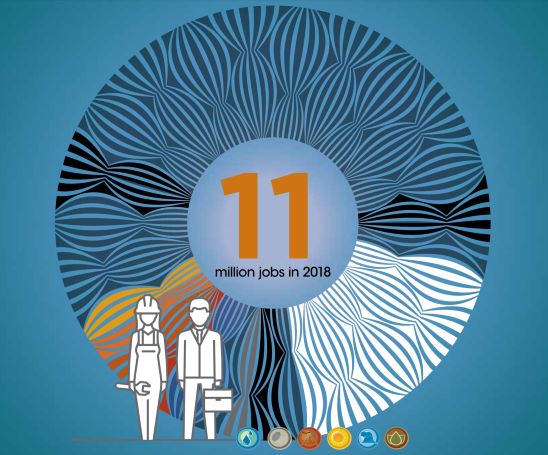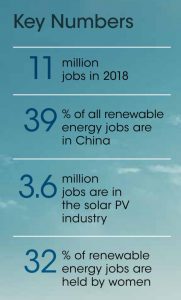

Eleven million people were employed by Renewable Energy sources around the world in the year 2018, according to the latest analysis by the International Renewable Energy Agency (IRENA). The year despite slump saw the number increase from a previous 10.3 million in 2017. IRENA’s Annual Review finds that renewables jobs grew to their highest level despite slower growth in key renewable energy markets including China.

The analysis brought some interesting developments to the forefront. Importantly, 32 % the renewable energy workforce is represented by women. It is higher than the 22 % average reported for the global oil and gas industry, the report showed.
The latest data also shows a change in the sector’s geographic footprint. Till recently the sector’s growth had been clustered around a few countries like China, the United States, and the European Union. Interestingly, however, East and Southeast Asian countries have emerged alongside China as key exporters of solar photovoltaic (PV) panels. Countries including Malaysia, Thailand and Viet Nam were responsible for a greater share of growth in renewables jobs last year. This allowed Asia to maintain a 60 % share of renewable energy jobs worldwide.
“Beyond climate goals, governments are prioritising renewables as a driver of low-carbon economic growth in recognition of the numerous employment opportunities created by the transition to renewables,” said Francesco La Camera, Director-General of IRENA. “Renewables deliver on all main pillars of sustainable development – environmental, economic and social. As the global energy transformation gains momentum, this employment dimension reinforces the social aspect of sustainable development and provides yet another reason for countries to commit to renewables.”
The Leaders
The biggest employers were:
Solar photovoltaic (PV) and wind remain the most dynamic of all renewable energy industries. Accounting for one-third of the total renewable energy workflow, solar PV retains the top spot in 2018, ahead of liquid biofuels, hydropower, and wind power. Geographically, Asia hosts over three million PV jobs, nearly nine-tenths of the global total. Latin American countries also witnessed growth, in step with rising regional PV demand.
Most of the wind industry’s activity still occurs on land and is responsible for the bulk of the sector’s 1.2 million jobs. China alone accounts for 44 % of global wind employment, followed by Germany and the United States. While China edged ahead of Europe in offshore wind investment in 2018, the US and North African markets have also begun converting oil and gas experience into offshore wind jobs. Off-grid renewables – along with expanding electricity access – have contributed to job creation across Africa and Asia.
Offshore wind could be an especially attractive option for leveraging domestic capacity and exploiting synergies with the oil and gas industry. Other Renewable energy jobs highlights:
The report added that employment opportunities are a key consideration in planning for low-carbon economic growth. Many governments have prioritised renewable energy development, firstly to reduce emissions and meet international climate goals, but also in pursuit of broader socio-economic benefits.
To read more click here
In a significant move toward advancing green energy and industrial growth in the state, Himachal…
Golabl chemical conglomerate BASF has announced that its now offering the world’s first biomass-balanced polyethersulfone…
In a crucial stint to bolster the biogas sector and sustainable dairying in the country,…
TotalEnergies SE has received approval to proceed with its Middlebrook solar and battery project in…
Andhra Pradesh Chief Minister Chandrababu Naidu has inaugurated the Rs 1,000-crore green hydrogen plant of…
The BITS Pilani has developed an innovative solution for managing landfill leachate, domestic septage, and…